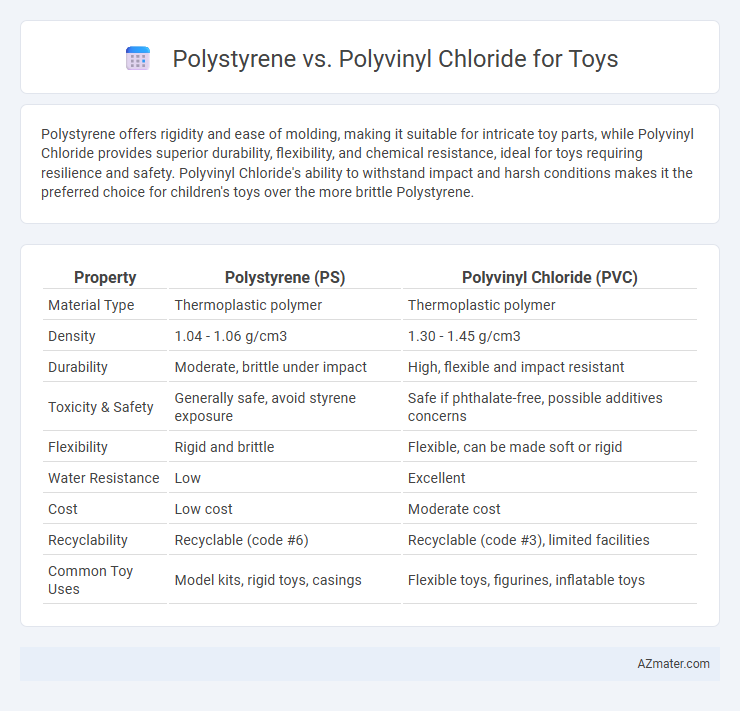Polystyrene offers rigidity and ease of molding, making it suitable for intricate toy parts, while Polyvinyl Chloride provides superior durability, flexibility, and chemical resistance, ideal for toys requiring resilience and safety. Polyvinyl Chloride's ability to withstand impact and harsh conditions makes it the preferred choice for children's toys over the more brittle Polystyrene.
Table of Comparison
| Property | Polystyrene (PS) | Polyvinyl Chloride (PVC) |
|---|---|---|
| Material Type | Thermoplastic polymer | Thermoplastic polymer |
| Density | 1.04 - 1.06 g/cm3 | 1.30 - 1.45 g/cm3 |
| Durability | Moderate, brittle under impact | High, flexible and impact resistant |
| Toxicity & Safety | Generally safe, avoid styrene exposure | Safe if phthalate-free, possible additives concerns |
| Flexibility | Rigid and brittle | Flexible, can be made soft or rigid |
| Water Resistance | Low | Excellent |
| Cost | Low cost | Moderate cost |
| Recyclability | Recyclable (code #6) | Recyclable (code #3), limited facilities |
| Common Toy Uses | Model kits, rigid toys, casings | Flexible toys, figurines, inflatable toys |
Introduction to Polystyrene and Polyvinyl Chloride
Polystyrene is a lightweight, rigid thermoplastic polymer commonly used in toy manufacturing due to its clarity, ease of molding, and affordability. Polyvinyl chloride (PVC) offers greater flexibility, durability, and chemical resistance, making it ideal for toys requiring softer, more impact-resistant materials. Both polymers serve distinct roles in the toy industry, with polystyrene favored for rigid components and PVC preferred for flexible parts.
Chemical and Physical Properties Comparison
Polystyrene exhibits excellent rigidity, clarity, and ease of molding, making it ideal for lightweight, transparent toys, while polyvinyl chloride (PVC) offers superior flexibility, durability, and chemical resistance, suitable for soft or impact-resistant toys. Chemically, polystyrene is a non-polar, aromatic hydrocarbon polymer prone to brittleness and UV degradation, whereas PVC contains chlorine atoms that enhance flame retardancy and resistance to oils and acids but may release harmful additives. Physically, polystyrene has a lower density (approximately 1.05 g/cm3) and less impact strength compared to PVC, which ranges between 1.3-1.45 g/cm3 and provides better toughness and weather resistance essential for long-lasting toys.
Safety Considerations in Toy Manufacturing
Polystyrene offers lightweight and clear plastic options but poses higher risks of brittleness and potential chemical leaching, raising safety concerns in toy manufacturing. Polyvinyl chloride (PVC) provides greater durability and flexibility but often requires plasticizers that can release harmful substances, necessitating strict regulation and testing to ensure child-safe use. Selecting materials with non-toxic additives and compliance with standards such as EN71 and ASTM F963 is crucial for minimizing health hazards in toys made from polystyrene or PVC.
Durability and Longevity of Toys
Polystyrene offers moderate durability suitable for lightweight toys but tends to become brittle over time, limiting its longevity. Polyvinyl Chloride (PVC) provides superior durability and flexibility, making it more resistant to impact and wear, which extends the toy's lifespan significantly. Toys made from PVC withstand rough play and environmental factors better, ensuring long-lasting performance compared to polystyrene-based toys.
Environmental Impact and Recyclability
Polystyrene (PS) and Polyvinyl Chloride (PVC) differ significantly in environmental impact and recyclability when used in toys. Polystyrene is lightweight and can be recycled through mechanical recycling processes, though it often faces contamination issues that limit its recyclability and contribute to microplastic pollution. Polyvinyl Chloride contains hazardous additives like phthalates and chlorine, complicating both recycling and disposal due to toxic dioxin release during incineration, making PVC less eco-friendly compared to polystyrene in toy manufacturing.
Cost Analysis: Production and Material Expenses
Polystyrene offers a lower production cost compared to polyvinyl chloride due to its simpler polymerization process and cheaper raw materials, making it an economical choice for toy manufacturing. However, polyvinyl chloride, despite its higher material expenses, provides enhanced durability and flexibility, potentially reducing long-term replacement costs. Evaluating initial production expenses alongside lifespan and safety features is crucial for optimized cost-effectiveness in toy applications.
Design Flexibility and Aesthetic Appeal
Polystyrene offers excellent design flexibility due to its ease of molding and ability to capture fine details, making it ideal for intricate toy designs with vibrant colors. Polyvinyl Chloride (PVC) provides superior durability and can be easily colored or made translucent, enhancing the toy's aesthetic appeal with varied textures and finishes. While polystyrene excels in smooth, rigid forms, PVC allows for softer, more flexible designs that can withstand rough handling and provide a tactile experience.
Regulatory Standards and Compliance
Polystyrene (PS) and Polyvinyl Chloride (PVC) exhibit distinct regulatory compliance profiles in toy manufacturing, with PS often favored due to its inert chemical properties and easier adherence to stringent safety standards such as ASTM F963 and EN 71. PVC poses challenges in meeting these regulations because of its potential release of harmful phthalates and chlorine-based additives, which are restricted under regulations like REACH and the US CPSIA. Compliance with these standards necessitates rigorous testing for both materials to ensure the absence of hazardous substances and to maintain child safety in toy applications.
Consumer Preferences and Market Trends
Consumer preferences for toys increasingly favor materials like polystyrene due to its lightweight, moldability, and cost-effectiveness, driving demand in the toy market. Polyvinyl chloride (PVC) remains popular for toys requiring durability and flexibility, especially in collectible figures and soft toys, despite concerns about plasticizers and environmental impact. Market trends indicate a gradual shift towards eco-friendly alternatives and safer formulations, impacting the demand and regulatory scrutiny of both polystyrene and PVC in the toy industry.
Conclusion: Choosing the Right Material for Toys
Polystyrene offers lightweight and cost-effective properties ideal for disposable or simple toys, while polyvinyl chloride (PVC) provides superior durability, flexibility, and resistance to impact, making it better suited for long-lasting and more complex toys. The choice depends on the toy's intended use, safety requirements, and environmental considerations, with PVC often preferred for its robustness and Polystyrene for its ease of manufacturing. Evaluating factors such as toxicity, recyclability, and mechanical performance ensures the right material selection for safe and sustainable toy production.

Infographic: Polystyrene vs Polyvinyl Chloride for Toy
 azmater.com
azmater.com